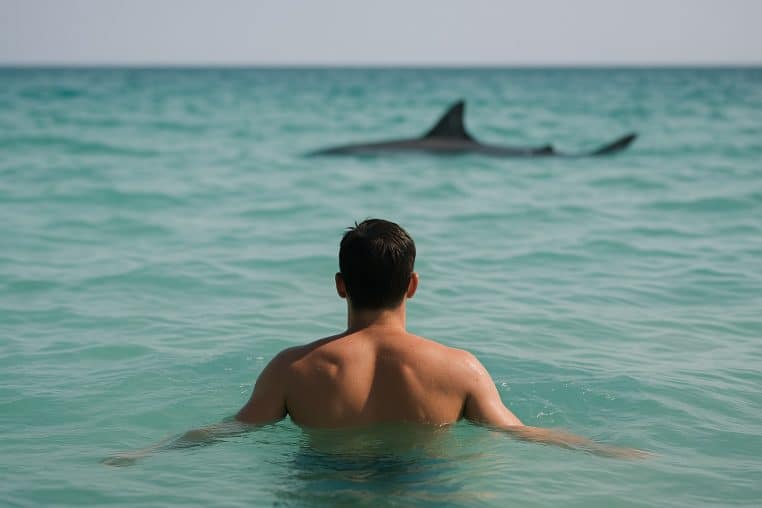Summer, sea … and its most dreaded inhabitants
Each year, in summer, millions of vacationers rush to the beaches, ready to dive into fresh and salty water. However, behind the postcard, the ocean remains the territory of a fascinating fauna … and sometimes impressive. Sharks are part of it, and their reputation has something to feed the chills. However, the statistics are formal: the probability of crossing an aggressive shark is tiny, much lower than that of injuring yourself on a shell or stumbling on a sand castle.
The continuation after this advertisement
These large predators are neither hungry nor systematically dangerous. They are especially cautious, curious and, most of the time, indifferent to our presence. But to avoid interested in error, some reflexes can be precious.


Sharks, between fantasy and reality
The image of the voracious shark, always ready to attack, is widely conveyed by films and certain spectacular images relayed on social networks. However, experts are clear: in the vast majority of cases, these animals do not see humans as a prey.
The continuation after this advertisement
The rest after this video
Neil Hammerschlag, a marine biologist and researcher in Nova Scotia, has observed sharks for more than two decades. He ensures that these marine predators are often much more intrigued by the noise of an engine than by a swimmer. Same observation on the side of Chris Lowe, director of the Shark Lab in California, who explains that the coastal sharks sometimes go under the surfboards without even modifying their trajectory.
Clearly, the danger is not constant. But as with any meeting with a wild animal, understanding their behavior and adopting the right gestures makes it possible to avoid unpleasant surprises.
The continuation after this advertisement


Observe what’s going on around you
When you bathe, it is easy to let yourself be carried by the waves and to forget what surrounds us. However, a regular glance around you can make the difference. Sharks, when they approach, often do it from the back. By remaining attentive to its environment, we reduce the risks of surprise.
Before getting into the water, it is also recommended to find out about the area: presence of fish in large numbers, fishing activity, or recent reports of marine animals. Better to know what type of water we venture.
The continuation after this advertisement


Choose the right time to swim
Light plays an important role in the behavior of sharks. At the first lights of the day, at dusk and during the night, their vision is adapted to the low light, which allows them to hunt more easily. At these times, they can confuse a swimmer or a surfboard with a usual prey.
To limit this risk of confusion, it is preferable to favor swimming in the middle of the day, when visibility is optimal and the activity of sharks is less intense.
The continuation after this advertisement

Leave your jewelry on the towel
Reflections in water can draw the attention of many marine animals, and sharks do not escape it. A collar, a bracelet or an earring that sparkles evokes, for them, the brilliance of the scales of a fish. It is a visual stimulus that can prick their curiosity.
For this reason, it is better to remove all the brilliant objects before entering the water. They will be more safe on your towel than in the waves.
The continuation after this advertisement
Avoid fishing areas
A fish that is struggling at the end of a line is a strong signal for a marine predator: this means that a meal may be within reach. The areas where fishermen are active therefore naturally attract sharks.
As a precaution, it is better to swim at a good distance from the lines and boats in the process of fishing, so as not to find yourself in the middle of this underwater agitation.
The continuation after this advertisement
Go away from hunting scenes
On the surface, some clues betray the presence of an underwater hunt: fish that jump out of the water, birds plunging into dive … These movements often reflect the presence of a bench of fish pursued by a predator.
Contrary to popular belief, the presence of dolphins does not guarantee the absence of sharks. These two species can hunt in the same areas. So, if you observe a ballet of fish and birds, it is better to change the bathing sector.
What to do with a shark?
The very idea can give chills, but it happens that swimmers or divers meet a shark. In this case, the main thing is to remain calm. Neil Hammerschlag insists: there is no point in trying to flee at full speed, because a shark is much faster than a human in the water.
The continuation after this advertisement
The good reflex consists in turning to the animal, looking at it and avoiding sudden movements. A shark that is known is often less inclined to approach more. Divers can also crouch in the bottom so as not to end up in its trajectory.


Simple gestures for an already minimal risk
In reality, most swimming go without the slightest interaction with these animals. The precautions mentioned here are mainly common sense and also apply to other marine situations.
The continuation after this advertisement
Sharks are part of the ecological balance of the oceans and, despite their frightening image, they are not the “serial killers” that we sometimes like to describe. By respecting their environment and remaining attentive, you can enjoy the sea in all serenity.
And the famous error to avoid absolutely?
All previous precautions count, but the most risky error remains … not to pay attention to what is happening around you. Sharks are discreet and can get closer to noise. Keeping your eyes open and staying aware of the environment is therefore the key to further reducing an already extremely low risk.

